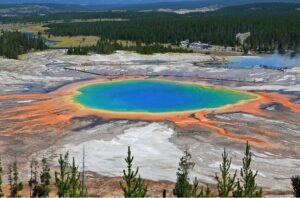
Figure: A Social Network (Wikimedia Commons, Author Zigomitros Athanasios – Thor4bp)
What is common between our social circles, the internet, and food webs?
They can be modeled as a bunch of interconnected nodes—a network. As simple as the definition of a network sounds, this diagram of nodes connected with edges contains more information than meets the eye. Different networks have different properties, defined by parameters such as the average number of edges a node in the network has, and how many steps it takes to get from one node to the other (Newman, 2003).
These properties help us understand the network’s behavior under different conditions. Take the food web as an example of a network. We know that some species in the food web have disproportionate effects on the ecosystem. If these species—called keystone species—go extinct, they can lead to a collapse of the ecosystem, or make it particularly vulnerable to invasive species (The National Geographic Society, 2019). Keystone species can be characterized by their location in the food web network—they tend to be connected to other species in the web through fewer steps, and the closest path between any two species tends to go through them (Jordán, 2009). That is, the network properties of the food web enable us to predict the consequence of removing a particular species from the ecosystem.
These properties may not remain constant over time. Networks evolve, and in specific ways. Most “birds of the same feather flock together.” Kossinets and Watts (2009) observe the origins of this behavior (called homophily) in college students, where similar students were more likely to become friends with one another. This could be because people prefer to make similar friends and also because similar people tend to put themselves in similar situations, inducing friendship among them, and therefore increasing the homophily. Current friendships determine the situations that the students might put themselves in, which then determines newer friendships. That is, the friendship connections among student nodes change as a function of the current network structure.
Friendships take a long time to form, and species take a long time to go extinct. What are the immediate effects of external shocks on a network? Until recently, researchers had not studied the precise effects of external stress events on network structure at fine-grained time scales.
In one of the first papers to study this issue, Romero et al. (2016) analyzed the impact of an external shock—a change in stock price—on the employees in a hedge fund. The nodes in the network were the employees (portfolio managers, traders, and analysts) and their outside contacts. The edges were the communications among the nodes through instant messages. Suddenly confronted with a large price change, theory suggested that the network could respond in either of two ways: it could “open up” or alternatively “turtle up” (Romero et al., 2016). If the network ‘opened up,’ it meant that the employees began to contact their weaker links—the outside contacts (Romero et al., 2016). Theories in sociology say that this observation would make sense. Whenever we face an adverse event, we try to maximize the amount, diversity, and novelty of knowledge to be able to better deal with the risk, which is best achieved by getting in touch with weaker contacts (Granovetter, 1973). However, if the network “turtled up,” it meant that the employees favored stronger ties: they favored communicating with people they already knew well. This, too, had been theorized by Staw et al. (1981), where external threats increase the cohesiveness of a group to seek consensus. There is value in getting information from trusted contacts—the stronger ties—during external threats.
In this case, the network was found to turtle up (Romero et al., 2016). When the price of the stock changed (in either direction), employees of the hedge fund company favored communicating among themselves rather than with their weaker outside links (Romero et al., 2016). Interestingly, employees favored communicating with fellow employees of their own type – e.g., traders favored communicating with traders more than portfolio managers and analysts (Romero et al., 2016).
Sudden price changes impact the content of the communication between the nodes (employees) of the network (Romero et al., 2016). The employees’ language could change—they could use more cognitive words (maybe thinking about and making complex decisions) or affective words (possibly an emotional response to the adversity) (Romero et al., 2016). Given that the network structure responds so strongly to adversity, could the network structure—specifically properties such as the number of edges between internal nodes versus between an internal and an external node, and the number of triangles, i.e., proportion of a person’s contacts who also have direct contacts between themselves—predict the language of the employees? That is, if an algorithm used current network properties that define its structure as its input, could it predict what type of messages the employees were sending each other? Indeed it could. Romero et al. (2016) find that the properties of the network alone could predict the language of the employees significantly better than could the price changes.
In addition to communication content, the network structure was also found to predict the hedge-fund company’s trading decisions. A classifier that used network structure as one of its predictors performed almost as well as a classifier that used network structure and price changes as predictors (Romero et al., 2016). That is, knowing the actual price change had almost no additional predictive power for trading decisions if one already knew the network structure.
The implications of these findings can extend far beyond interactions in a hedge fund company. Imagine how the structure of a social network might be affected when confronted with a natural disaster. Indeed, there have been such findings. When faced with Hurricane Sandy, the network of tweets turtled up in the local geographical area that was affected by the hurricane (Kogan et al., 2015). Most people in the affected area became more active than they otherwise would, and the network of specific retweets became denser among the locals who were affected (Kogan et al., 2015). Imagine another example: a network that models interactions between contacts. Would a highly transmissible disease spread less rapidly if it were accompanied by an external stressor like food shortage? A food shortage is an external stress event, that may cause the network to turtle up. This would decrease the number of novel interactions, which would give the disease less chances to spread. Could the food shortage possibly be a good predictor of the rate at which the disease would spread? Developments in the study of networks have the potential to shed light on these questions.
I thank Professor Daniel Romero for taking the time to help me better understand his paper and the literature and for his comments on this essay.
References
Granovetter, M. S. (1973). The Strength of Weak Ties. American Journal of Sociology, 78(6), 1360–1380.
Jordán, F. (2009). Keystone species and food webs. Philosophical Transactions of the Royal Society B: Biological Sciences, 364(1524), 1733–1741. https://doi.org/10.1098/rstb.2008.0335
Kogan, M., Palen, L., & Anderson, K. M. (2015). Think Local, Retweet Global: Retweeting by the Geographically-Vulnerable during Hurricane Sandy. Proceedings of the 18th ACM Conference on Computer Supported Cooperative Work & Social Computing, 981–993. https://doi.org/10.1145/2675133.2675218
Kossinets, G., & Watts, D. J. (2009). Origins of Homophily in an Evolving Social Network. American Journal of Sociology, 115(2), 405–450. https://doi.org/10.1086/599247
Newman, M. E. J. (2003). The Structure and Function of Complex Networks. SIAM Review, 45(2), 167–256. https://doi.org/10.1137/S003614450342480
Romero, D. M., Uzzi, B., & Kleinberg, J. (2016). Social Networks Under Stress. Proceedings of the 25th International Conference on World Wide Web, 9–20. https://doi.org/10.1145/2872427.2883063
Society, N. G. (2019, September 5). Role of Keystone Species in an Ecosystem. National Geographic Society. http://www.nationalgeographic.org/article/role-keystone-species-ecosystem/
Staw, B. M., Sandelands, L. E., & Dutton, J. E. (1981). Threat Rigidity Effects in Organizational Behavior: A Multilevel Analysis. Administrative Science Quarterly, 26(4), 501–524. https://doi.org/10.2307/2392337
Related Posts
Strength in Numbers: How Community Enhances Perceived Support
Figure 1: Bandmates join in a group hug. The powerful...
Read MoreIntergenerational Trauma: How a history of pain brings biological costs
Source: Nicolas Raymond, CC BY 2.0 A few years ago,...
Read MoreThermophilic Life in Yellowstone National Park Challenges the Physical and Chemical Limits of Survival
Cover Image: Grand Prismatic Spring in Yellowstone National Park (Source:...
Read MoreInvestigating the Quality of Healthcare in Rural Areas
Cover Image: A rural Metro ambulance in Memphis, Tennessee. Rural...
Read MoreIncarceration and Motherhood: A Brief Overview of Maternal Health Issues in American Prisons
Figure 1: Guards in prisons are able to put prisoners...
Read MoreThe Public Health Humanitarian Crisis in Ukraine
This publication is in proud partnership with Project UNITY’s Catalyst Academy 2023...
Read MoreAnusha Kallapur






